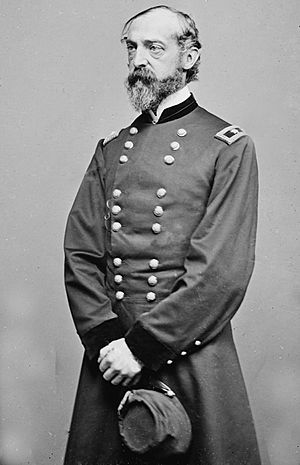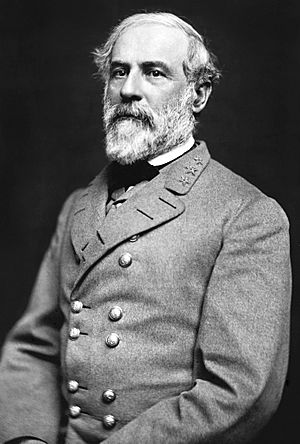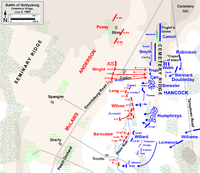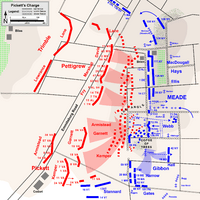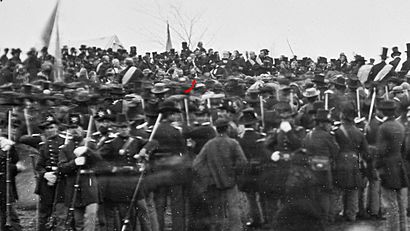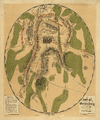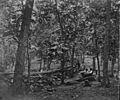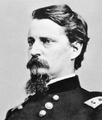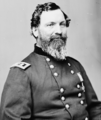Battle of Gettysburg facts for kids
Quick facts for kids Battle of Gettysburg |
|||||||
|---|---|---|---|---|---|---|---|
| Part of the American Civil War | |||||||
 The battle of Gettysburg, Pa. July 3d., 1863, by Currier and Ives |
|||||||
|
|||||||
| Belligerents | |||||||
| Commanders and leaders | |||||||
| George G. Meade | Robert E. Lee | ||||||
| Strength | |||||||
| 93,921 | 71,699 | ||||||
| Casualties and losses | |||||||
| 23,055
(3,155 killed
14,531 hurt 5,369 captured/missing) |
23,231
(4,708 killed
12,693 hurt 5,830 captured/missing) |
||||||
The Battle of Gettysburg was a major fight during the American Civil War. It happened from July 1 to July 3, 1863, near Gettysburg, Pennsylvania. This battle had the most casualties (soldiers killed, wounded, or missing) of the entire war. Many people call Gettysburg the turning point of the war.
During the battle, Union Major General George G. Meade's Army of the Potomac stopped attacks by Confederate General Robert E. Lee's Army of Northern Virginia. This defeat ended Lee's second invasion of the North. Lee began to move his soldiers back to Virginia on July 4. Between 46,000 and 51,000 soldiers from both sides were casualties in these three days.
On the same day, the Siege of Vicksburg also ended with a Union victory. In November of that year, a cemetery was opened for the soldiers who died at Gettysburg. President Abraham Lincoln gave a famous speech there, known as the Gettysburg Address. He honored the fallen soldiers from both sides.
Contents
Why the Battle Happened
After winning a big battle at Chancellorsville in Virginia in May 1863, General Lee led his Confederate army north. He wanted to invade the North for a second time. This was called the Gettysburg Campaign.
Lee had several goals for this invasion. He hoped to capture Harrisburg, Pennsylvania, the state capital. He thought this would embarrass President Lincoln and make Northern politicians want to end the war. Lee also hoped a victory in Pennsylvania would encourage the Northern peace movement. He also wanted other countries to recognize the Confederacy as an independent nation. Finally, Lee badly needed supplies for his army, and he planned to get them in Pennsylvania. Harrisburg was a major railroad center and a large supply depot.
In the North, President Lincoln told Union Major General Joseph Hooker to follow Lee's army. But Hooker was slow to act. Lincoln lost trust in him. So, on June 28, just three days before the Battle of Gettysburg, Lincoln replaced Hooker with General Meade.
First Day of Fighting: July 1
Neither General Lee nor General Meade planned for the battle to start at Gettysburg. They weren't even there when it began.
On June 30, 1863, Confederate General Henry Heth sent his soldiers to Gettysburg. He was looking for supplies, especially shoes. This is why some people mistakenly think the battle started over shoes. The real reason was that 10 roads met at Gettysburg. Both armies had sent troops in that direction.
Heth's soldiers marched into Gettysburg without checking what was ahead. The Confederate cavalry, led by J.E.B. Stuart, was supposed to scout ahead, but they were missing. So, Heth's men ran right into a Union cavalry division led by General John Buford. This started the fighting. Even though Lee had ordered his commanders not to start a major battle, more and more troops arrived, and it became a full-scale battle. Lee decided he would have to fight the Union army at Gettysburg.
The battle began around 5:30 a.m. on July 1. Buford's cavalry slowly fought Heth's Confederates, giving the Union time. Around 10 a.m., the Union I Corps arrived, led by General John F. Reynolds. They set up defenses along McPherson's Ridge. Reynolds was killed during the fighting, but the Confederates were pushed back.
Both sides brought in more soldiers. The Union set up defenses around the town. The Union I Corps defended the western side, and the XI Corps defended the north. Buford's cavalry covered their sides. One Union division was kept ready on Cemetery Ridge.
In the afternoon, General Lee arrived. The Confederates still didn't know how strong the Union forces were. They also hadn't scouted the land well. Confederate attacks pushed the Union I and XI Corps back. By 4 p.m., both Union corps retreated through Gettysburg. They took up strong positions on Cemetery Ridge.
By the end of the first day, the Union had lost about 9,000 men, including 3,000 captured. The Confederates had lost about 6,500 men. So, the first day seemed like a Confederate victory in terms of numbers. However, the Union troops now held the high ground, and more Union soldiers were still arriving. Lee felt confident he could defeat Meade at Gettysburg.
Late that day, Lee ordered Confederate General Richard S. Ewell to take Cemetery Ridge "if practicable" (if possible). Ewell had looked at Cemetery Ridge and decided it was too difficult to take that night. He chose to wait until the next day. This was a big mistake for the Confederates. The Union army ended the day with about 21,900 men strongly placed on Culp's Hill and Cemetery Ridge. The Confederate army had about 27,000 men.
Second Day of Fighting: July 2
On the second day, most of both armies had arrived. The Union line held the high ground in a defensive shape that looked like a fishhook.
On July 2, Lee ordered General James Longstreet to attack the Union's left side as early as possible. At the same time, General A. P. Hill's soldiers were to attack the Union center. General Ewell was to make smaller attacks and, "if practicable," attack the Union's right side. Lee believed that if his plan worked and the Union line broke, the battle, and maybe the war, would be won that day.
Lee's plan needed all the soldiers to get into position and artillery to move up. Longstreet had the furthest to go. On their march, they realized the Union lines could see them. They had to go back and take a different path. Longstreet's attack didn't start until about 4 p.m. His attack lasted over three hours but could not break the Union line. Hill's attack in the center was not effective. Ewell did not attack Cemetery Ridge as Lee had hoped, but he did make some progress on Culp's Hill.
Union Major General Daniel Sickles made a big mistake. He was a political general (a general appointed for political reasons, not just military skill). He disobeyed Meade's orders and moved his troops forward to the Peach Orchard. He was supposed to stay on Little Round Top and connect with other Union forces. By moving, he left a large gap in the Union line.
Sickles marched his men nearly a mile in front of the main Union line, with no support. Within an hour, Longstreet's attack almost destroyed his entire III Corps. Sickles was badly wounded by a cannonball and lost a leg. Being wounded saved him from being punished. Sickles' mistake almost cost the Union the entire battle.
On the night of July 2, General George Pickett's large division arrived for the Confederates. Lee placed them in the center of the Confederate line. Lee's plan for the next day was to attack both the Union right and left, just like he had tried before. Lee was still sure he could break the Union line and win. That day, Stuart's cavalry finally caught up with Lee's army. Lee ordered Stuart to ride around Gettysburg and attack the Union from behind. Ewell also received more soldiers and was ordered to take Culp's Hill the next morning.
Meade ordered the Union XII Corps to push Ewell's forces off the captured trenches on Culp's Hill. They were to attack at daylight the next morning. Meade decided the rest of the Union Army would hold its position and wait for Lee to attack.
Third Day of Fighting: July 3
Ewell's attack on Culp's Hill began at first light. Lee rode to Longstreet's headquarters and found that Longstreet had misunderstood his orders. Longstreet was planning a different kind of attack. With no hope of a coordinated attack, Lee changed the plan. Longstreet was now to attack the Union center on Cemetery Ridge. Ewell's forces failed their counterattacks and had to leave Culp's Hill by about 11:00 a.m. Lee put all his hopes on Longstreet's attack on the center. Longstreet had the last fresh division in Lee's army, led by Pickett.
The Cannon Battle

First, about 140 Confederate cannons fired at the Union lines. This loud attack started around 1 p.m. About 80 Union cannons fired back. The cannon duel lasted for about an hour. The Confederate artillery chief, General Edward Porter Alexander, wanted it to last only 25 minutes. But he saw it wasn't doing much damage, so he kept going. He also worried about running out of ammunition for Pickett's upcoming attack. When the Union guns fell silent, Alexander thought he had knocked them out. But it was a trick by the Union artillery chief. The Union guns were saving their fire for the attack they knew was coming. Alexander then told Pickett to start his attack.
The sound of the cannons was so loud it could be heard as far away as Philadelphia. It was probably the loudest noise ever heard in North America at that time. The Confederate cannons may have killed about 200 Union soldiers in an area later called the "bloody angle." But the Union guns likely killed even more Confederate troops.
Pickett's Charge
Calling the Confederate attack on the Union center "Pickett's Charge" can be a bit confusing. First, Pickett commanded only one of the three main groups in the attack. Second, it wasn't a fast "charge." It was a slower advance over a long distance. These Virginia soldiers were joined by other Confederate units whose numbers were smaller after two days of fighting. When the cannons stopped, Pickett asked Longstreet for permission to start the attack. Longstreet, who thought the attack would fail, just nodded silently. Longstreet had tried to convince Lee to cancel the attack, but Lee wouldn't listen.
Over 12,000 Confederates marched out from the trees and formed up for the long walk forward. Waiting for them behind a low stone fence on Cemetery Ridge were about 5,000 Union troops, mostly from General Winfield Scott Hancock's II Corps. This happened between 2:00 and 3:00 p.m.
As they marched about a mile, Union artillery killed many soldiers. Rifle fire from the Union line was very strong. The Union troops used four lines of soldiers. As one line fired, they moved back to reload while the next line moved up to fire. Only a few hundred Confederates reached the Union line. Within minutes, they were dead or dying, or captured. The attack lasted about an hour, and over 7,000 Confederate soldiers were killed. As the remaining Confederates retreated, Lee was heard saying, "this was all my fault." He then told Pickett to gather his division. Pickett famously replied, "General, I have no division."
At the same time as this main attack, Stuart's cavalry attacked the Union rear, but that attack also failed.
What Happened After the Battle
Lee's army entered Pennsylvania with 75,054 men. He lost 22,638 soldiers, about 30% of his army. The Union also lost many officers. The Union I Corps and III Corps lost so many men that they had to be combined with the II Corps.
Gettysburg took more American lives than any other battle in United States history. It is still the largest battle ever fought on American soil.
The Union victory at Gettysburg ended Lee's invasion of the North. Lee would never try to invade the Union again. The Army of Northern Virginia never fully recovered its strength. However, the supplies they took during their time in Pennsylvania helped the Confederate army keep fighting. The wagon train of supply wagons and ambulances for the wounded was over 17 miles (27.3 km) long. This is why Gettysburg is called the turning point of the American Civil War.
General Meade was criticized for not attacking Lee after the third day. The next day, July 4, Meade sent out small groups of soldiers, but he did not launch a full attack. Lee kept his army on Seminary Ridge all day. The more than 10,000 wounded men were moved by wagon train 40 miles (64 km) to Williamsport. From there, they crossed the Potomac River into Virginia. The rest of Lee's army followed on the night of July 4–5, protected by Jeb Stuart's cavalry.
The next day, the Union army cautiously followed when they found the Confederates had left. At the Battle of Falling Waters, Lee's army was waiting for the flooded Potomac River to go down so they could cross. Meade's forces caught up with them, but the battle had no clear winner. The Battle of Falling Waters was the last battle of the Gettysburg Campaign.
The Gettysburg Address
The damage from the war was still clear in Gettysburg more than four months later. On November 19, the Soldiers' National Cemetery was dedicated. During this ceremony, President Abraham Lincoln honored the soldiers who had died. He also spoke about the new meaning of the war in his famous Gettysburg Address.
Interesting Facts About Gettysburg
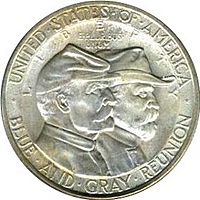
- Some women also fought in the Civil War. One of them died at Gettysburg.
- There were 120 Generals present at Gettysburg.
- The battle did not start because of "shoes," as some stories say. It happened because 10 roads met at Gettysburg, and both armies sent troops there.
- On the first day of battle, 16,000 men died.
- So many wounded Confederates were going back to Virginia that the wagon train was 17 miles (27.3 km) long.
- There were 72 Medals of Honor given for the Gettysburg Campaign. 64 of these were for actions during the battle itself. The first was given in December 1864. The last Medal of Honor was given posthumously (after he had died) to Lieutenant Alonzo Cushing in 2014.
Images for kids
-
Northern Virginia, Maryland and Pennsylvania, 1861–1865
-
This 1863 map shows the Gettysburg Battlefield during July 1–3, 1863. It shows troop positions, roads, and houses.
-
This 1862 illustration shows Confederate soldiers taking captured African American civilians south into slavery. On their way to Gettysburg, the Army of Northern Virginia kidnapped about 40 black civilians.
-
Robert E. Lee's plan for July 2, 1863, the second day of the Battle of Gettysburg
-
Union Army breastworks on Culp's Hill, 1863
-
The high water mark on Cemetery Ridge with the 72nd Pennsylvania Infantry Monument and the Copse of Trees, August 2005
-
Winfield Scott Hancock, a Union Army major general, commanded the Union Army's II Corps at the Battle of Gettysburg
-
Alfred Waud sketching the Battle of Gettysburg for Harper's Weekly
-
Maj. Gen. John F. Reynolds, USA
-
Maj. Gen. Winfield Scott Hancock, USA
-
Maj. Gen. Daniel Sickles, USA
-
Maj. Gen. George Sykes, USA
-
Maj. Gen. John Sedgwick, USA
-
Maj. Gen. Oliver Otis Howard, USA
-
Maj. Gen. Henry Warner Slocum, USA
-
Maj. Gen. Alfred Pleasonton, USA
-
Lt. Gen. James Longstreet, CSA
-
Lt.. Gen. Richard S. Ewell, CSA
-
Lt. Gen. A. P. Hill, CSA
See also
 In Spanish: Batalla de Gettysburg para niños
In Spanish: Batalla de Gettysburg para niños


